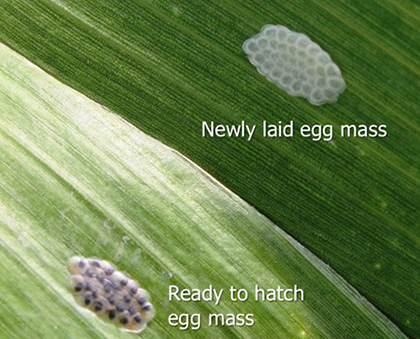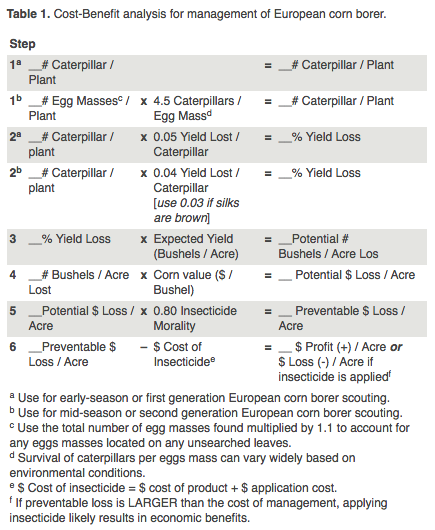By Adam Varhenhorst, Extension Entomologist
European corn borer is a significant pest of corn in South Dakota. The European corn borer caterpillars tunnel into corn stalks and ear shanks resulting in reduced yields and secondary infection by fungi.
Further information on the European corn borer life cycle in South Dakota, identification, and injury to corn can be found in 2016 Scouting Recommendations for European Corn Borer. Management of European corn borer over the last 15 years principally consisted of planting of Bt corn hybrids, and there have been very few reports of cornfields that were damaged by European corn borers in the past decade. However, due to the lower price of corn and the cost associated with Bt corn, some farmers have elected to plant non-Bt corn.
Severe European corn borer infestations in non-Bt cornfields have recently been documented in other states. European corn borer can be successfully managed in non-Bt cornfields, however successful management requires a season-long scouting plan.
Scouting
Scouting for European corn borer should begin once extended leaf height exceeds 17 to 21 inches.
Earlier in the season, adult moths are attracted to the tallest corn so begin scouting in earlier planted cornfields. In areas of the state where European corn borer completes two generations per year, second generation moths are attracted to corn with green silks and shedding pollen.

Early Season: Scouting early season corn focuses on finding European corn borer caterpillars. For each cornfield, sample at least 5 different sections within the field (10 different areas would be preferable).
Remove and unfurl the whorls of 10 plants for each section of a sampled field and count the number of live European corn borer caterpillars.
Be sure to randomly select corn plants to sample; sampling only plants with signs of caterpillar feeding injury will result in overestimating European corn borer populations and potentially spending money on an unwarranted insecticide treatment.
Also, make sure to measure the length of any caterpillars found within the sampled whorls and also how many are observed. If caterpillars are less than ¼ inch in length waiting to spray fields is advised because more caterpillars may hatch or existing caterpillars may die from natural causes.
Resample the field within 3 to 5 days. If an insecticide application is warranted, be sure to spray before caterpillars exceed 11/16 inch in length. Caterpillars exceeding 11/16 inch will begin to tunnel into corn stalks and are relatively safe from foliar applied insecticides.
Mid-Season: Scouting corn mid-season or specifically for second generation European corn borer focuses on searching for egg masses.
For each cornfield, sample at least 5 to 10 different sections within the field. Search the underside of leaves of at least 20 plants for each section of the field for egg masses (Figure 1). Egg masses are typically laid on the middle leaves, so search the middle 7 leaves (3 above and 3 below the ear).
Multiply the total number of egg masses found for each field by 1.1 to account for any eggs masses located on any unsearched leaves. If an insecticide application is warranted, be sure to spray before caterpillars exceed 11/16 inch in length and tunnel into corn stalk and ear shanks.
Management

Applying insecticides to manage European corn borer is complicated by the value of corn, the cost and efficacy of insecticides, and the survival and development of European corn borer caterpillars.
Table 1 outlines a cost-benefit analysis of management of European corn borer; if preventable loss is greater than the cost of management, applying insecticide will likely result in economic benefits.
Again, scouting for caterpillars is critical for successful insecticide applications because larger caterpillars are protected from insecticides once they tunnel into corn plants. For a list of conventional insecticides that are labeled for management of European corn borer, please see South Dakota Pest Management Guide: Corn.






Post a comment
Report Abusive Comment